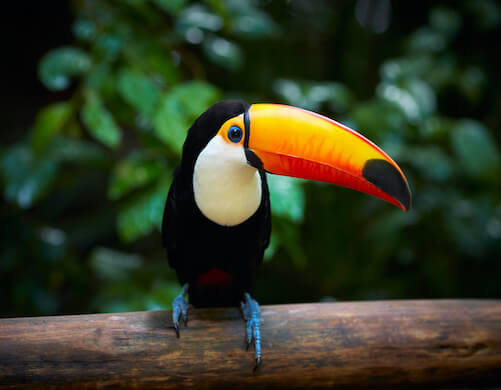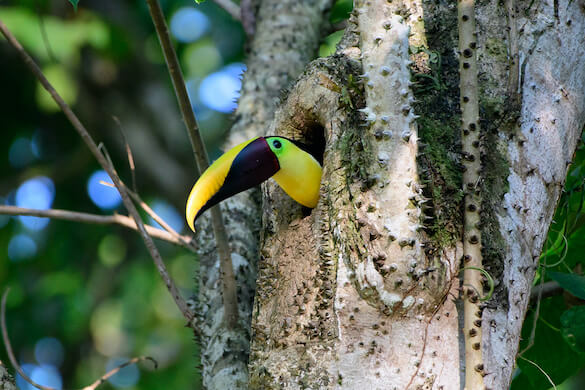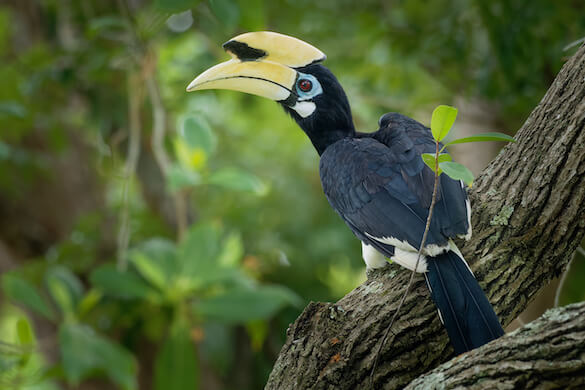
| Kingdom | Animalia |
| Phylum | Chordata |
| Class | Aves |
| Order | Piciformes |
| Family | Ramphastidae |
| Genus | 5 different genera |
| Species | Over 40 different species |
| Niche | Frugivorous tropical bird |
| Length | 11.5 – 29 inches ( 29 – 63 cm) |
| Weight | 0.3 – 1.5 lbs ( 130 – 680 g) |
| Lifespan | 20 years |
| Social Structure | Social, live in flocks |
| Conservation Status | Most species ‘Least Concern’, certain species ‘Endangered’ |
| Preferred Habitat | Lowland or montane forest |
| Average Clutch Size | 2 – 4 eggs |
| Main Food Item | Fruits |
| Predators | Monkeys, snakes, birds of prey, cats |
The Basics
Toucans are a group of over forty species of colorful bird native to the forests of southern Mexico, Central America and South America. The toucan family of birds comprises the araçaris, toucanets and toucans, all of which are renowned for their large, colorful beaks that in some species measure more than half their body length.
The araçaris are a genus of medium-sized toucans with colorful plumage and contrastingly patterned beaks. The toucanets comprise two genera of relatively small toucans with differing plumage. Whilst one toucanet genus is made up of birds with predominantly green plumage, the other is sexually dichromatic, thus males and females exhibit different plumage colors and patterns.
The toucans comprise two genera that are found in different habitats. One genus is made up of medium-sized birds with multicolored plumage found in highland forests in the Andes mountains, whereas the other is made up of the largest toucans, all of which have predominantly black plumage and inhabit lowland regions. The largest and probably most famous toucan species is the toco toucan. This is also the only species of toucan that is not forest-dwelling, instead being found in savannahs with open woodlands and forest patches.
Behaviour and Ecology
Toucans are highly social and associate in flocks of 20 or more birds. Toucans are extremely noisy birds and use a range of calls to communicate with each other, likely to signal good foraging sites or to warn of danger. Despite their social tendencies, toucans are thought to be monogamous, with pairs leaving their flocks to breed in the spring and returning with their chicks once the breeding season is over.
Toucans normally lay between two to four eggs. Chicks hatch with no feathers and closed eyes, so are completely dependent on their parents until they are around three weeks old, when they open their eyes and begin to grow feathers. Chicks generally remain in the nest for six to eight weeks in total, during which time their initially small beak will grow almost to completion. Toucans nest in tree cavities, although they do not create their own holes, instead relying on those previously made by woodpeckers or created naturally by loss of tree branches.

Despite their large beaks and long tails, which measure from half to the full length of their body, toucans are quite adept at fitting into small tree cavities. This is because toucans’ tails are attached to their spines via a unique ball and socket joint, so it can be flipped over their heads to take up less room while sleeping.
Although toucans are mainly fruit-eating birds, they will also eat insects, small reptiles and amphibians. Additionally, toucans plunder the nests of other birds, consuming both chicks and unhatched eggs. Supplementing their frugivorous diet in this way is especially important for young birds to help them grow. Whilst toucans are not migratory, the four species of mountain toucan move up and down the Andes mountains following the seasonal availability of food.
Fun Facts about Toucans
From their huge beaks to their bright colors, the adaptations of toucans provide examples of a number of interesting biological concepts.
A Multipurpose Beak
Despite being extremely large, toucan beaks are actually very light, being composed of a light-weight network of bony fibres covered by keratin. Even so, growing such a large beak must require a lot of energy, leading scientists to propose a number of hypotheses for how the toucan’s large, brightly colored beak could provide a selective advantage.
For example, it is thought that large beaks aid foraging, as they allow toucans to pick fruits from multiple locations around them without moving their bodies, thus conserving energy. Large beaks also help toucans reach food unavailable to other animals, such as in deep tree cavities or at the end of thin branches that cannot hold much weight.

It has been suggested that the bright colors of toucan beaks might serve a purpose in courtship rituals and species recognition, as beak coloration differs between species. Furthermore, their bright beaks might help toucans scare off predators that they are not able to defend themselves against, or even other birds when plundering their nests.
It has recently been discovered that toucan beaks also play an important role in thermoregulation. This is because toucans are able to control the flow of blood into their beaks, increasing the flow to aid heat loss and reducing the flow to conserve heat. It has been shown that toucan beaks are extremely efficient thermal windows and their ability to radiate heat even rivals that of elephants’ ears.
Although the exact selective forces that led to the evolution of toucan beaks are still unknown, it seems likely that a number of factors, including foraging ability, species recognition, predator defence and thermoregulation all played a part in driving the development of the toucans’ large and colorful beaks.
Seeing Double
You might have noticed that toucans look remarkably similar to another group of birds, the hornbills. But whilst toucans are found in the Americas, hornbills are native to Africa and Asia, and are not closely related to toucans at all. In fact, toucans are most closely related to woodpeckers and share a number of adaptations with these birds (see below).
Toucans and hornbills are therefore an example of convergent evolution, having separately evolved similar adaptations to fill their shared niche on their respective continents. Importantly, the analogous features of these birds were not present in their last common ancestor, but have developed in each group since they split into two separate lineages.

Other examples of convergent evolution include the independent development of wings in birds and bats, as well as the independent evolution of streamlining in dolphins and sharks, which look remarkably similar despite one being a mammal and one being a fish.
Poor Fliers
Unsurprisingly given their huge beaks, long tails and short wings, toucans are not particularly good at flying. As a result, they have a number of adaptations that help them move around without using their wings. For example, similar to other poor fliers such as jungle fowl, toucans have short, strong legs. Toucans also have two toes pointing forwards and two toes pointing backwards, a trait they share with their woodpecker relatives. This configuration helps toucans grip onto branches, providing strength and stability whilst walking or hopping through their forest habitat.

Due to their reduced aerial mobility, toucans are poor dispersers and cannot fly long distances over water. As a result, toucans are not native to the West Indies, despite being found throughout the close-by regions of Central and South America.
